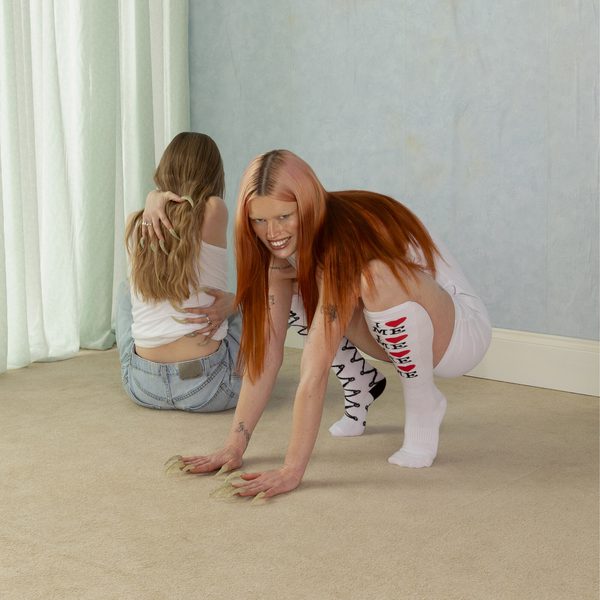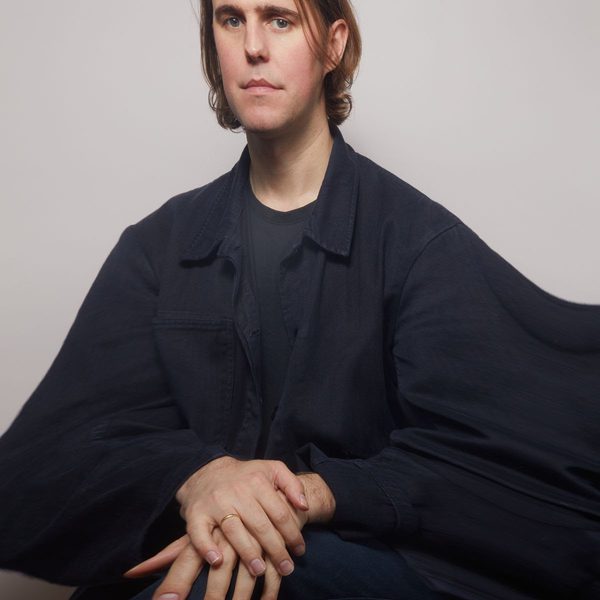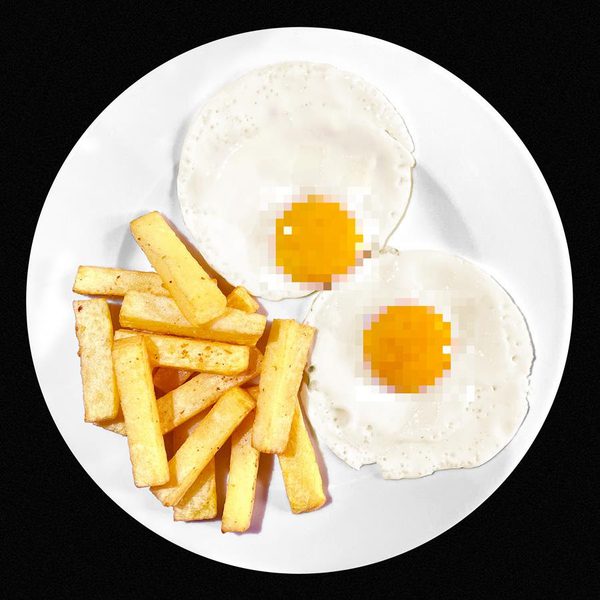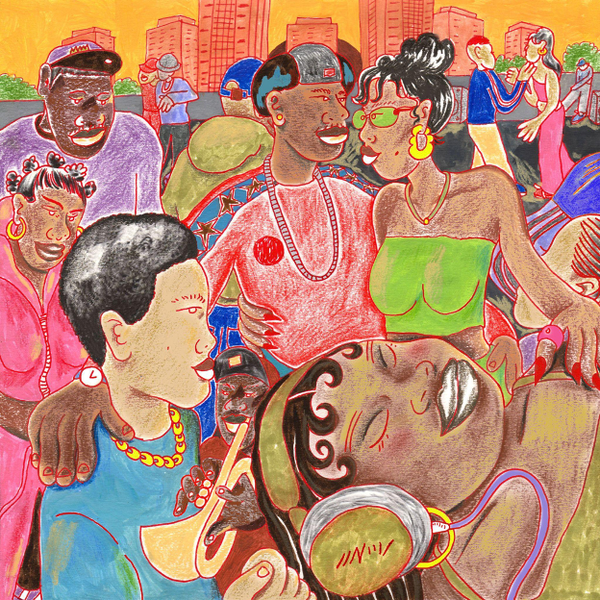
Embodying Afrofuturism
Jamila Woods explains her fascination with Afrofuturism to Victoria Parkey and how it fits into the celebration of blackness, of women, and of Chicago that sits at the heart of her debut album.
On paper, meeting Jamila Woods should have been at least a bit intimidating – she has a Brown University degree to her name, collaborations with Chance the Rapper and Macklemore & Ryan Lewis under her belt and mounting success since the release of her debut album, HEAVN.
In actuality, she’s the opposite. We’re meeting before her sold out show at Camden’s Jazz Café - she comes across as kind, as well as deeply intelligent and thoughtful, pausing to consider before answering questions and never providing anything less than an incredibly eloquent and well-thought-out response. The show itself borders on perfection - the intimacy of the space feels like a party, juxtaposed with the definite impression that we’re watching an artist oozing with so much talent and presence that it’s almost unthinkable that she won’t go on to become a superstar.
Jamila’s debut HEAVN, is one that I’ve played almost every day since its release in August (although it came out last year in the US). It's perfectly suited for almost any moment - I’ve turned to it without hesitation while getting ready to go out, when I’ve been feeling stressed, sad, or happy, whilst hanging out with friends drinking wine, over the office speakers, and whilst lounging in bed. It’s one of those rare albums you instantly fall in love with, and it’s one of those magical albums that - while being intensely important and political - can also be danced to.
HEAVN is also celebration of blackness, a celebration of women, a celebration of Chicago, and a protest against the current political climate of America.
Today, we’re discussing Afrofuturism - a subject that Woods feels passionate about and has been researching and learning more and more about, allowing it to influence her music and her poetry. It’s difficult to pinpoint a specific definition of Afrofuturism because of the sheer broadness of what it can and does encompass - whether it be science-fiction, literature, film, fashion or aesthetics. Despite the ‘futurism’ aspects of it, it is also deeply rooted in black history - a reimagining and a way of envisioning the past, present and future through a black lens.
“How I learned about it, was as a way of imagining black people in the future because that in itself is a revolutionary act when black people are subject to systemic violence every day,” explains Woods. “[While it’s] kind of a way of imagining black people in the future, it’s also reimagining black history, because a lot of times black history is taught in a very white-centric way, or in a very reductionist way… I remember Krista [Franklin] saying once that there are scholars and authors who are really associated with Afrofuturism, but there are so many branches to it, like it’s not only just one thing, and there’s different schools within it I guess you could say.”

Krista Franklin - a collage artist, poet, and colleague of Woods’ at the non-profit Young Chicago Authors has proved to be an important mentor figure in Woods’ life and career: “She’s a good example to me that you can be more than one thing, because for a while I was like; I am a poet and I am a singer, but do I have to choose one in order to be proficient in either? So that’s a really big inspiration to me. She’s also a healer and I think that’s something I connect my artistic practice to. She always says art isn’t therapy - because sometimes people might conflate the two and that can be dangerous - but that your wellbeing and your spiritual wellbeing is very connected to your ability to be creative.”
The term Afrofuturism is perhaps confusing, initially, because the expression suggests looking only towards the future, but so much of it can be found rooted in tradition and history with natural imagery, like gold and water, playing a significant role in its aesthetics and symbolic references - it marries up both tradition and myth with more sci-fi-centric ideas and ciphers and allows for the creation of a vision of blackness that hasn’t necessarily been represented in mainstream culture before.
One striking image that Woods refers to in her music is the Myth of the Flying Africans, which interested her after she came across it in Toni Morrison’s book, Song of Solomon. “I don’t think [Toni Morrison’s] really talked about as an Afrofuturist writer, but the image in that book of that black man flying around... I became obsessed with it and I looked it up and she’s referencing the Flying African myth - though maybe in a more subtle way than Octavia Butler writing about things,” she says. “When I started researching Afrofutrism there’s this whole group of people who were reimagining the Middle Passage, thinking of the people - a lot of pregnant women who jumped overboard - and not that they died, but that they built an underwater colony and lived there. So that’s what the lyrics of ‘Heavn’ are referencing when it says 'I don’t wanna run away with you, I just wanna jump the boat with you, when we dance the ocean waves,' I think that’s an image I’m kind of obsessed with.”
The title track she refers to - undoubtedly one of the standout songs of the album - marries dreamy keyboard sounds with a laidback drumbeat. It’s produced by The Roots, so it sounds like the sun on your back on a summer day, and opens with an interpolation of the lyrics of The Cure’s "Just Like Heaven", but goes on to explore and reimagine deeper historical events. “The song ‘Heavn’ is talking about love and how to envision love happening in places where there are barriers set up against it - so Chicago, but also thinking about slavery times when slavery was literally splitting up families, splitting up black people who were in love, and how to love in spite of that.”
"I think Afrofuturism again gives permission and gives artists space to be our authentic selves."
It’s impossible to discuss Afrofuturism without mentioning Sun Ra - the multidisciplinary jazz musician, artist, poet, and philosopher, who hailed - like Woods - from Chicago (though he claimed to be an alien from Saturn). Sun Ra remains such an archetypal image of Afrofuturism because of the extent to which he embodied it - not only with in his artistic work, but also in his mentality, his aesthetic, and his influence.
“I just really admire his ability and his faith in his own vision basically, because he was probably seen as a weirdo by a lot of people and he wasn’t really of the present time,” says Woods. “He was of a different time and was so interdisciplinary with work - a poet, songwriter, musician, so I really admire that about Sun Ra [as well as] the creativity of his costumes.” That’s not to say images of Afrofuturism can’t be seen in the musicians of 2017 - the more you learn about it, the more it’s apparent that it plays a huge part in our pop culture - you only need to look as far as Erykah Badu, Childish Gambino, and Grace Jones to see the aesthetic in its full effect.
“I think [Afrofuturism] again gives permission and gives artists space to be our authentic selves in a way”, Woods comments, “especially when there’s a lot of independent artists too who aren’t beholden to [labels saying] 'you have to be like this to be an R&B singer or a soul singer', so Solange can be - I mean she probably could be anyone she wanted to be anyway - but she can be experimental and kind of push the boundaries in that way.”

While Afrofuturism is finding itself become commonplace and fundamental within a lot of mainstream music, the film and television industry seems to be catching up - though at a slightly slower pace. There’s a lot to be said for John Boyega being cast as the first black Stormtrooper in Star Wars: The Force Awakens, but the controversy and criticism it drew shows just how much work there is left to be done. “It’s interesting, the difference between music and film. I think about that a lot these days because my friend wrote a web series that got picked up by HBO and so sometimes we talk about the differences.” Woods states. “Lena Waithe from Master of None was talking about how if it’s a queer black woman role, [it’s her who’s] getting calls to write it or play it - which is good because before it would be a white man who writes it - but the problem is ‘now they’re calling me and only me for like, everything - and there’s more, not just me.’ So I think there is something in film and TV that’s happening that’s like ‘oh, people like to see diversity and authenticity’. They’re starting to get it but they’re a little slow because they’re also like ‘let’s get this one person to do it again and again.’”
While sci-fi can often seem to be a boys’ game, there are strong feminist underpinnings to the foundations of Afrofuturism, which is perhaps why it lends itself to its elements being aestheticized in varying degrees by artists like Beyoncé, Janelle Monáe, and even Willow Smith. No doubt part of this is due to Afrofuturist sci-fi author, Octavia Butler, being such a fundamental figure in the establishment of the movement. “I read the Xenogenesis series by Octavia Butler, and it’s the first time I remember reading a black protagonist of a science fiction story. It’s also the idea of centering a black woman in the story like that that was really powerful to me. It is artists like that who give us permission as a black woman to center themselves in the story they tell,” Woods explains. It’s this centering of black women, and giving them a platform following years of oppression, that makes Afrofuturism such a powerful and important tool for black femininity. “I think that speaks to the shift that needs to happen because for so long black women have been the backbone of different black movements through history but have still been oppressed in ways that haven’t been addressed by those movements. I think a lot of black women voices are in the conversation of Afrofuturism, and I think that’s in part because it’s a tool towards that liberation and also that’s kind of a corrective measure, maybe.”
"I think it would be really cool for Afrofuturism to be taught more especially in schools with a lot of marginalized students - people of colour, or immigrant populations, or queer populations."
It’s the positioning and centering of black protagonists where they may not usually be found when written through a white lens that makes Afrofuturism so essential on a wider scale beyond literature, film, and music, and why Woods believes it should be more integrated into education. “I think it would be really cool for it to be taught more especially in schools with a lot of marginalized students - people of colour, or immigrant populations, or queer populations. I’m also an educator and I work at the non-profit [Young Chicago Authors], and a lot of times we’re taught as educators to teach students about future orientation. We want them to be thinking ‘what are you going to do when you graduate?’ or ‘what job do you want to have?’ You want them to have a goal to attach to and I think it’s interesting when students of colour are expected to care about the future when their school is actually really shitty or no one has jobs in their neighborhood, or there’s all these structural things against making them care about the future.”
It’s through Afrofuturism’s inherent linking between past, and present that a new way of perceiving and imagining the future can be realized.
“You can’t forget or erase your present concerns or your historical concerns and care about the future, but you have to understand the relationship between the two of them - which I think Afrofuturism does," says Woods. "Some of my friends have taught HEAVN in that way, [by asking] ‘what would you imagine as your ideal world and what would that mean would have to change in your present world?’ To me it’s really fun to teach stuff related to Afrofuturism so I would hope that it would be more widely taught."
"Learning about history in a sort of one-sided way can cause black people or anyone who’s in the marginalized oppressed group to believe negative or falsehoods about themselves that make them feel less than, and therefore limit their capacity to imagine more for themselves. So for me it’s really linked the black history and black future. ”

Building upon the threads of Afrofuturist imagery and references that run throughout HEAVN, Woods also uses the reimagining of history in her works of poetry, in particular, a new series that she is working on that reimagines the Bible, she explains. In it, she mixes tradition with modern language, and depicts Adam and Eve as being black - and it’s a perfect example of how well Afrofuturism lends itself to blending the past with the future, and tradition with modernity.
“[The series of poems is] rewriting the Book of Genesis but about black hair - like the genesis of how black hair was created. So I think that’s the link between traditionally Christian stories and Afrofuturism - to me it is that reimagining. So the first poem is called ‘How Our Hair Got This Way’ and it’s basically talking about the moment with Adam and Eve and the apple and saying after God found out that they ate the apple, he grabbed the snake and stretched it so thin that it popped into all these coils and he put the coils on both of their heads and was like: 'Adam, your [coils] are going to fall out over time because you snitched'. It’s using language of today but a past story and reimagining it. To me that was really influenced when I started reading a lot of Afrofuturistic artists.”
"Octavia Butler wrote down all the goals that she wanted for her life, and all the things came true. I thought that that was really powerful because it’s clear she was practicing that idea of manifesting the future in her actual personal daily life too."
It’s interesting to see just how easily and effectively Afrofuturism slots itself into storytelling, songwriting, and poetry, but it’s also clear that it influences Woods’ every day life as well. We end our conversation back on the topic of Octavia Butler, arguably the mother of Afrofuturism and an indisputable influence. “I just love the thing that Octavia Butler wrote in her notebook. She wrote down all the goals that she wanted for her life, and all the things came true. I thought that that was really powerful because it’s clear she was practicing that idea of manifesting the future in her actual personal daily life too.” I ask Jamila if she’s tried manifestation too. “Yeah, I think it was before I saw that actually. My Mom and people would always talk about affirmations so there were three things I wrote and I had them on my bulletin board when I first started considering being a solo artist. It was like ‘I can make music on my own’, ‘I will perform in front of thousands of people’, ‘I will make music that feels healing to people’, and I just had that on my bulletin board.”
It seems a poignant note to end on and one that really resonates with me when I watch her performing a couple of hours later, because it’s clear from watching her - looking like she was born to be on stage - and feeling the reaction and mood from the crowd that she’s well on her way towards achieving those manifestations, whether it’s through the law of attraction or through sheer talent.
Follow Victoria Parkey on Twitter at @vndrlyl
Get the Best Fit take on the week in music direct to your inbox every Friday

Wet Leg
moisturizer

MF Tomlinson
Die To Wake Up From A Dream

BIG SPECIAL
National Average





